Science Olympiad Model Test Papers - 1 | Science Olympiad for Class 5 PDF Download
Note: The questions provided in this document are similar to the questions that were asked in the actual Olympiad exam. So, we recommend you study these for your Olympiad preparation.
Logical Reasoning
Q1: Select a figure from the options which will continue the same series as established by the Problem Figures. (a)
(a)  (b)
(b)  (c)
(c)  (d)
(d) 
 View Answer
View Answer 
Ans: (d)
From the pattern, it appears that:
- The black dot moves in a clockwise direction along the edges of the square.
- The cross within the circle rotates by 90 degrees with each step.
Following this pattern, the correct answer would be the option in which:
- The black dot is in the next position in the clockwise sequence.
- The cross has rotated by another 90 degrees.
Q2: If Rohan is facing the swimming complex and he turns 135° in a clockwise direction, what will Rohan be facing finally?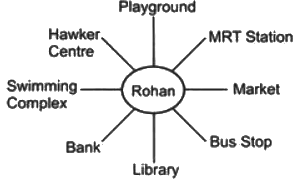
(a) bus stop
(b) hawker centre
(c) mrt station
(d) library
 View Answer
View Answer 
Ans: (a) bus stop
Starting Position: Rohan is initially facing the Swimming Complex.
Turn Angle: He turns 135° clockwise.
Degrees per Step: Each adjacent position around Rohan represents a 45° turn.
Steps Calculation: 135° / 45° = 3 steps in the clockwise direction.
Clockwise Steps:Starting from the Swimming Complex:
1st step: Bank
2nd step: Library
3rd step: Bus Stop
Q3: Which of the following options best depicts the relationship amongst "Authors, Teachers, Men"?
(a)  (b)
(b)  (c)
(c)  (d)
(d) 
 View Answer
View Answer 
Ans: (a)
Analyzing the relationship between "Authors," "Teachers," and "Men."
- Authors and Teachers can be overlapping groups because a person can be both an author and a teacher.
- Men can also overlap with both Authors and Teachers, as some authors and teachers may be men. However, not all authors or teachers are men (there are also female authors and teachers).
The best way to represent this relationship is with three overlapping circles, where each circle partially overlaps with the other two, allowing for the possibility that some people can belong to one, two, or all three categories.
Q4: Select the odd one out:
(a) 135
(b) 243
(c) 158
(d) 405
 View Answer
View Answer 
Ans: (c)
- The numbers 135, 243, and 405 are all odd numbers, while 158 is an even number.
- Odd numbers are not divisible by 2, whereas even numbers are.
- Thus, 158 stands out as it does not share the same property as the others.
- This makes 158 the odd one out in this selection.
Q5: Which of the following options will complete the pattern in Fig. (X)? (a)
(a)  (b)
(b)  (c)
(c)  (d)
(d) 
 View Answer
View Answer 
Ans: (c)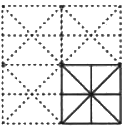
- Each square in the grid is divided by diagonal lines that form an "X" pattern, with additional lines in each quadrant.
- Option (c) shows the same structure as the other squares, completing the pattern accurately.
Q6: If all the numbers are removed from the given arrangement, then which of the following is second to the right of the fifth element from the left end?
Arrangement: W 3 K 5 © N 8 P 4 T M 9 F Q
(a) M
(b) ©
(c) K
(d) N
 View Answer
View Answer 
Ans: (a)
Remove all numbers:
After removing all numbers (3, 5, 8, 4, and 9), the arrangement becomes:W K © N P T M F Q
In this sequence, the fifth element is P.
Identify the element that is second to the right of this fifth element (P):
Moving two positions to the right of P, we get M.Q7: Select a figure from the options in which Fig. (X) is exactly embedded as one of its part.  (a)
(a) (b)
(b)  (c)
(c)  (d)
(d)
 View Answer
View Answer 
Ans: (a) Option (a) is the correct choice because it contains the exact embedded shape of Fig. (X).
Option (a) is the correct choice because it contains the exact embedded shape of Fig. (X).
Q8: In a specific coding system, if TORCH is represented as 7#@84 and SHARP is represented as 54©@6, what will be the code for PATCH in the same system?
(a) 4©875
(b) 6#8©@
(c) 5@874
(d) 6©784
 View Answer
View Answer 
Ans: (d)
- TORCH is represented as 7#@84.
- SHARP is represented as 54©@6.
Step-by-Step Breakdown:
Identify Letter Mappings:
- From TORCH (T, O, R, C, H) → 7, #, @, 8, 4
- T → 7
- O → #
- R → @
- C → 8
- H → 4
- From SHARP (S, H, A, R, P) → 5, 4, ©, @, 6
- S → 5
- H → 4
- A → ©
- R → @
- P → 6
- From TORCH (T, O, R, C, H) → 7, #, @, 8, 4
Determine PATCH:
- P → 6
- A → ©
- T → 7
- C → 8
- H → 4
Combine the Codes:
- P A T C H → 6 © 7 8 4
Matching with the Options:
- Option (d) 6©784 corresponds exactly to the derived code.
Q9: Arrange the following words in the order they would appear in a dictionary and choose the right option: 1. Create, 2. Correct, 3. College, 4. Crime, 5. Camera
(a) 5, 1, 2, 3, 4
(b) 5, 3, 2, 1, 4
(c) 4, 1, 3, 5, 2
(d) 2, 1, 5, 3, 4
 View Answer
View Answer 
Ans: (b)
- Camera comes first because it starts with 'C' and is the earliest in alphabetical order.
- Crime is last, as it starts with 'C' but comes after all the other words.
- Create comes after 'Correct' since it starts with 'C' as well but has a later letter.
- Correct is next, as it starts with 'C' and comes after 'College'.
- College follows as it also starts with 'C' but comes after 'Camera'.
Q10: If in a certain code language, SUBSTITUTION is written as ITSBUSNOITUT. Then how will DISTRIBUTION be written in that language?
(a) IRTSIDNOITUB
(b) IRTSIDNOIBUT
(c) IRTDISNOITUB
(d) IRTDISNOIUTB
 View Answer
View Answer 
Ans: (a)
Science
Q11: Complete the given analogy and select the option that correctly identifies
X: Sundari tree : Marshy areas :: X : Coastal areas
(a) Opuntia
(b) Fir
(c) Black pepper plant
(d) Cedar tree
 View Answer
View Answer 
Ans: (c)
- The analogy compares the Sundari tree, which is typically found in marshy areas, to another plant that grows in coastal areas.
- The Black pepper plant is known to thrive in coastal regions, making it the correct choice for X.
- Other options like Opuntia, Fir, and Cedar tree do not specifically relate to coastal environments.
- Thus, the correct answer is (c) Black pepper plant.
Q12: Select the incorrect match:
(a) Evergreen tree - Neem
(b) Coniferous tree - Deodar
(c) Deciduous tree - Elm
(d) None of these
 View Answer
View Answer 
Ans: (d)
- Evergreen trees
- Coniferous trees
- Deciduous trees
- Since all the matches are correct, the option None of these is the right answer.
Q13: Select the incorrect statement about vertebrates:
(a) They all have backbones.
(b) Some can live both on land and in water.
(c) All vertebrates have scales as their body covering.
(d) Some vertebrates have hollow or air-filled bones.
 View Answer
View Answer 
Ans: (c)
- Vertebrates are animals that possess a backbone, which is a key characteristic.
- While some vertebrates, like amphibians, can live both on land and in water, not all have the same body covering.
- The statement that "all vertebrates have hair" is incorrect; many do not have hair at all.
- Some vertebrates, such as birds, actually have hollow or air-filled bones, which help them fly.
Q14: Which of the following is classified as a marsupial?
(a) Snake
(b) Goat
(c) Scorpion
(d) Kangaroo
 View Answer
View Answer 
Ans: (d)
- Kangaroo is the correct answer because it is a type of marsupial, which means it carries and nurses its young in a pouch.
- In contrast, a snake is a reptile, a goat is a mammal but not a marsupial, and a scorpion is an arachnid.
- Marsupials are primarily found in Australia and nearby islands, with kangaroos being one of the most well-known examples.
- Understanding the classification of animals helps in recognizing their unique characteristics, such as the pouch in marsupials.
Q15: What does the following picture suggest?
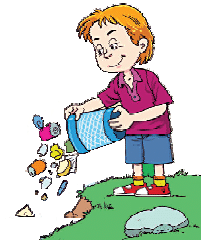
(a) Poor sanitation conditions.
(b) Breeding ground for mosquitoes and disease-causing microbes.
(c) Unhealthy living.
(d) All of the above.
 View Answer
View Answer 
Ans: (d)
The picture depicts poor sanitation conditions, breeding ground for mosquitoes and unhealthy living.
Q16: Aman took part in a race. He drank glucose just before the race began. This means that glucose:
(a) Makes our bones stronger
(b) Helps to build muscles
(c) Gives energy instantly
(d) Aids in digestion
 View Answer
View Answer 
Ans: (c)
- Glucose is a simple sugar that provides a quick source of energy.
- When Aman drank glucose before the race, it was to ensure he had enough energy to perform well.
- Unlike other options, which focus on muscle building or bone strength, glucose is primarily used for instant energy.
- This is why athletes often consume glucose or energy drinks before competitions.
Q17: Why do we place naphthalene balls between layers of clothing during storage?
(a) Naphthalene enhances the brightness of clothes
(b) Naphthalene safeguards clothes from insects
(c) Naphthalene improves the color of clothes
(d) Both A and C
 View Answer
View Answer 
Ans: (b)
- Naphthalene balls are used to protect clothes from insects like moths that can damage fabric.
- They release a strong smell that acts as a repellent, keeping the clothes safe during storage.
- Using naphthalene is a common practice to ensure that clothes remain in good condition.
- Options A and C are incorrect because naphthalene does not enhance brightness or color.
Q18: What should be used for treating an ant bite?
(a) Paste of baking soda
(b) Amla juice
(c) Hot oil
(d) Red chili paste
 View Answer
View Answer 
Ans: (a)
- Paste of baking soda is effective because it helps to neutralize the acidity from the ant bite, reducing irritation.
- Applying this paste can provide relief from itching and swelling.
- Other options like amla juice or hot oil do not have the same soothing effect on ant bites.
- Using red chili paste could actually worsen the irritation instead of helping.
Q19: Refer to the given figure showing the respiratory system and answer the questions that follow.
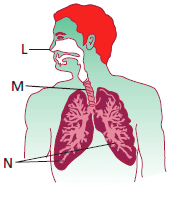
A. Which of the labelled parts is protected with the rib-cage?
B. In which of these labelled parts, exchange of gases takes place?
(a) A-M; B-L
(b) A-N; B-L
(c) A-N; B-N
(d) A-M; B-N
 View Answer
View Answer 
Ans: (c)
Lungs (N) are protected with the rib cage as well as exchange of gases takes place here.
Q20: A basketball has a maximum volume capacity of 450 mL. It is filled with 430 mL of air. An air pump is used to pump another 50 mL of air into the basketball. What will be the final volume of air inside the basketball without bursting it?
(a) 430 mL
(b) 450 mL
(c) 480 mL
(d) 500 mL
 View Answer
View Answer 
Ans: (b)
- The maximum volume of the basketball is 450 mL.
- Initially, it contains 430 mL of air.
- When 50 mL of air is added, the total would be 480 mL.
- However, since the maximum capacity is 450 mL, it cannot exceed this limit.
- Thus, the final volume of air inside the basketball will be 450 mL without bursting it.
Q21: Identify the part ‘X’ in the given part of the skeletal system. (a) Muscle
(a) Muscle
(b) Joint
(c) Nerve
(d) Vessel
 View Answer
View Answer 
Ans: (b)
‘X’ in the given figure is a joint. A joint is the place where two bones meet. Most joints are movable.
Q22: Radha pushed against a wall but was unable to shift it. What does this indicate?
(a) Energy is not spent but work is done
(b) Energy is spent but work is not done
(c) Energy is not spent and work is not done
(d) Energy is spent and work is done
 View Answer
View Answer 
Ans: (b)
- Radha's action of pushing the wall demonstrates that she exerted force, which means she used energy.
- However, since the wall did not move, no work was accomplished in the physics sense, as work requires movement in the direction of the force.
- This situation illustrates that energy can be expended without resulting in work being done.
- Thus, the correct conclusion is that energy is spent but work is not done.
Q23: Which of the following activities will not have a negative impact on the environment?
(a) Burning of fossil fuels
(b) Planting trees in a nature reserve
(c) Using herbicides in a crop field
(d) Increasing the use of chlorofluorocarbons (CFCs)
 View Answer
View Answer 
Ans: (b)
- Planting trees in a nature reserve is beneficial for the environment as it helps in carbon absorption, improves air quality, and provides habitat for wildlife.
- In contrast, activities like burning fossil fuels and using CFCs contribute to pollution and climate change.
- Using herbicides can harm local ecosystems and biodiversity.
- Thus, planting trees is a positive action that supports environmental health.
Q24: Select the option that accurately orders the Sun, Earth, and Moon by their size from smallest to largest.
(a) Sun, Moon, Earth
(b) Sun, Earth, Moon
(c) Moon, Earth, Sun
(d) Moon, Sun, Earth
 View Answer
View Answer 
Ans: (c)
- The Moon is the smallest of the three celestial bodies.
- The Earth is larger than the Moon but significantly smaller than the Sun.
- The Sun is the largest, being a massive star at the center of our solar system.
- Thus, the correct order from smallest to largest is Moon, Earth, Sun.
Q25: If an earthquake happens, what actions should you take?
(a) If you are indoors, stay in and get under a desk or table.
(b) If you are outdoors, stay away from trees and buildings.
(c) If you are on a beach, run towards the water.
(d) Both A and B
 View Answer
View Answer 
Ans: (d)
- During an earthquake, it's crucial to know the right steps to ensure your safety.
- If you are indoors, the best option is to stay inside and take cover under a sturdy piece of furniture like a desk or table.
- If you are outdoors, you should keep your distance from trees and buildings to avoid falling debris.
- Options A and B are both correct, making option D the right choice.
Q26: A compass works with the help of:
(a) Solar energy
(b) Moon’s gravity
(c) Earth’s magnetic field
(d) Earth’s gravity
 View Answer
View Answer 
Ans: (c)
- A compass is a tool used for navigation and direction finding.
- It operates based on the Earth’s magnetic field, which allows the compass needle to align itself with the magnetic north.
- This means that the compass points towards the magnetic poles of the Earth, helping users determine direction.
- Other options like solar energy, moon’s gravity, and Earth’s gravity do not play a role in how a compass functions.
Q27: In __________, we allow a mixture of sand and water to sit in a jar without movement for a while, allowing the sand to settle at the bottom. The clear water is then carefully poured into a different jar. This process is known as _______.
(a) Sedimentation, Filtration
(b) Decantation, Evaporation
(c) Sedimentation, Decantation
(d) Condensation, Filtration
 View Answer
View Answer 
Ans: (c)
- Sedimentation is the process where solid particles, like sand, settle at the bottom of a liquid when left undisturbed.
- After sedimentation, the clear liquid can be carefully poured out, which is known as decantation.
- This method is useful for separating solids from liquids without using filters.
- In this case, the sand settles, and the clear water is poured into another container, demonstrating both sedimentation and decantation.
Q28: Select the activity that represents a chemical change.
(a) Melting of ice-cream
(b) Rusting of iron nails
(c) Making curd from milk
(d) Both B and C
 View Answer
View Answer 
Ans: (d)
- Chemical change involves a transformation that alters the chemical composition of a substance.
- In this case, rusting of iron nails and making curd from milk are both processes that change the original materials into new substances.
- Melting of ice-cream is a physical change as it only changes the state of matter without altering its chemical structure.
- Thus, the correct answer is Both B and C as they both exemplify chemical changes.
Q29: Which of the following is an example of non-renewable energy?
(a) Solar energy
(b) Hydro energy
(c) Nuclear energy
(d) Geothermal energy
 View Answer
View Answer 
Ans: (c)
Nuclear energy is a renewable source of energy while others are non-renewable energy sources.
Q30: ........... is the collection of billions of stars, gases and dust:
(a) Planet
(b) Sun
(c) Asteroid
(d) Galaxy
 View Answer
View Answer 
Ans: (d)
The universe is made up of millions of galaxies. It is made up of millions of galaxies. Galaxies are the collection of billion of stars, gases and dust. The Milky Way is one of them.
Q31: Select the incorrect match.
(a) Air - Influenza
(b) Direct contact - Diabetes
(c) Contaminated food and water - Cholera
(d) Insect - Plague
 View Answer
View Answer 
Ans: (b)
- Direct contact is typically associated with the transmission of infectious diseases, not chronic conditions like Diabetes.
- Plague is transmitted by insects, specifically fleas.
- Thus, option (b) is the only one that does not correctly match a disease with its mode of transmission.
- Influenza spreads through the air, while Cholera is caused by contaminated food and water.
Q32: Select the correct match.
(a) Garba - Rajasthan
(b) Ghoomar - Gujarat
(c) Chhau - West Bengal
(d) Lavani - Punjab
 View Answer
View Answer 
Ans: (c)
- Chhau is a traditional dance form that originates from West Bengal, making option (c) the correct match.
- Option (a) incorrectly pairs Garba with Rajasthan; it is actually from Gujarat.
- Option (b) pairs Ghoomar with Gujarat, which is correct, but not the answer we are looking for.
- Option (d) incorrectly associates Lavani with Punjab; it is a dance from Maharashtra.
Q33: Read the given paragraph where a few words are italicized and select the correct option regarding them: Bones are majorly made up of minerals like calcium and potassium. They contain a hard tissue called bone marrow where blood cells are destroyed.
(a) Calcium must be changed to sodium.
(b) Potassium must be changed to phosphorus.
(c) Hard must not be changed as it is correctly mentioned.
(d) Destroyed must be replaced with decomposed.
 View Answer
View Answer 
Ans: (b)
- Potassium is one of the minerals in bones, and the question suggests changing it to phosphorus, which is also a mineral but not typically found in the same context as potassium in bones.
- The term hard accurately describes the tissue of bones, so it should remain unchanged.
- The word destroyed refers to the process of blood cell formation and is appropriate in this context.
- Thus, the correct option is to change potassium to phosphorus, making option (b) the right choice.
Q34: What will occur if the small intestine is taken out of the digestive system?
(a) (ii) only
(b) (ii) and (iii) only
(c) (i) and (iii) only
(d) (i), (ii), and (iii)
 View Answer
View Answer 
Ans: (b)
- Removing the small intestine disrupts the absorption of nutrients, leading to malnutrition.
- The small intestine is crucial for breaking down food and absorbing vitamins and minerals.
- Without it, the body cannot effectively utilize the nutrients from the food consumed.
- This results in serious health issues, including weight loss and deficiencies.
Q35: Replace the numbers in the given figure by correct terms.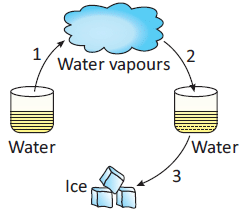
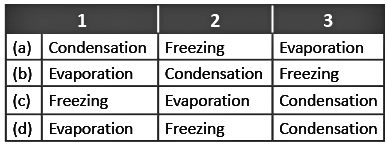
 View Answer
View Answer 
Ans: (b)
The label 1 represents the process of evaporation (water to water vapour), label 2 is condensation (water vapour to water), and label 3 is freezing (water to ice).
Q36: Diesel is produced through the refining of:
(a) Kerosene
(b) Petroleum
(c) Coal
(d) Metallic minerals
 View Answer
View Answer 
Ans: (b)
- Diesel fuel is primarily derived from the process of refining petroleum, which is a natural resource.
- The refining process involves separating and purifying different components of crude oil.
- While kerosene and coal are also fuels, they are not the main sources for diesel.
- Understanding the source of diesel is important for energy and fuel discussions.
Q37: Which among the following is an active volcano?
(a) Mauna Loa
(b) Mount Everest
(c) Mauna Kea
(d) Mount Kilimanjaro
 View Answer
View Answer 
Ans: (a)
- Mauna Loa is recognized as an active volcano located in Hawaii.
- It has erupted numerous times in the past, with its last eruption occurring in 2022.
- In contrast, Mount Everest and Mauna Kea are not classified as active volcanoes.
- Understanding the difference between active and dormant volcanoes is crucial in geology.
Q38: Read the below sentences. Which of these are NOT correct?
(A) It is very difficult to compress gas.
(B) Steel, wood, and fabric are all solid forms of matter.
(C) Most matter changes its state when more energy is added to it.
(D) Solids contract on heating.
(a) A and C
(b) B and C
(c) C and D
(d) A and D
 View Answer
View Answer 
Ans: (c)
Solids expands on heating
Q39: Select the correct statement regarding the food chain.
(a) Food chains can exist independently.
(b) Many food webs are interlinked to form a food chain.
(c) All food chains start with green plants.
(d) In the food chain, carnivores are the first consumers and herbivores are the second consumers.
 View Answer
View Answer 
Ans: (b)
Food web is a network of interconnected food chains existing in an ecosystem.
Q40: A brick is positioned at a height of 10 meters above the ground. If the brick is elevated to a height of 15 meters from the ground, then the potential energy of the brick will _________.
(a) Increase
(b) Decrease
(c) Remain same
(d) Cannot say
 View Answer
View Answer 
Ans: (a)
- The potential energy of an object is determined by its height above the ground.
- When the height of the brick is increased from 10 meters to 15 meters, it gains more potential energy.
- Potential energy is directly proportional to height; thus, as height increases, potential energy also increases.
- Therefore, the correct answer is that the potential energy of the brick will increase.
Q41: Speed of light in vacuum is:
(a) 3 × 108 km/h
(b) 3 × 108 m/s
(c) 3 × 108 m/h
(d) 3 × 108 m/s
 View Answer
View Answer 
Ans: (b)
Speed of light in vacuum is 3 × 108 m/s.
Q42: In which of the following pairs are the two components miscible with each other?
(a) Water, Orange juice
(b) Water, Carbon dioxide
(c) Water, Milk
(d) All of these
 View Answer
View Answer 
Ans: (c)
- Miscibility refers to the ability of two substances to mix together uniformly.
- In this case, water and milk are miscible because they can blend together to form a homogeneous mixture.
- On the other hand, orange juice and carbon dioxide do not mix well with water, making them immiscible.
- Thus, the correct answer is (c) Water, Milk, as they can mix completely.
Q43: Select the option that correctly identifies monocot and dicot seeds:
(a) Rice - Pea
(b) Wheat - Corn
(c) Pea - Rice
(d) Corn - Wheat
 View Answer
View Answer 
Ans: (a)
- Monocotsdicots have seeds with two cotyledons.
- In this case, rice is a monocot, and pea is a dicot.
- The other options mix monocots and dicots incorrectly.
- Thus, the correct pairing is Rice - Pea as it accurately represents one monocot and one dicot.
Q44: Select the accurate statement:
(a) More UV rays lead to acid rain.
(b) Higher levels of CO2 in the air result in global warming.
(c) Lower carbon dioxide levels in the atmosphere can lead to ozone layer depletion.
(d) An increase in oxygen levels in the atmosphere raises the temperature.
 View Answer
View Answer 
Ans: (b)
- Higher levels of CO2 in the atmosphere trap heat, which contributes to global warming. This is a well-established scientific fact.
- While UV rays and acid rain are related, they do not directly cause each other.
- Decreasing carbon dioxide does not lead to ozone depletion; in fact, ozone depletion is primarily caused by chemicals like CFCs.
- Increasing oxygen does not significantly affect atmospheric temperature.
Q45: Which of the following is hard, opaque, and lustrous?
(a) Wooden log
(b) Sponge
(c) Copper spoon
(d) Rubber tyre
 View Answer
View Answer 
Ans: (c)
- Hard: The material must be solid and not easily deformed.
- Opaque: It does not allow light to pass through, meaning you cannot see through it.
- Lustrous: It has a shiny surface that reflects light well.
- The only option that meets all these criteria is the Copper spoon, as it is a metal that is both hard and shiny.
Achievers Section
Q46: Study the given flowchart. The label I and II represents :
(a) l-carbon dioxide, II-oxygen
(b) l-oxygen, II-respiration
(c) I-respiration, II-carbon dioxide
(d) l-respiration, II-oxygen
 View Answer
View Answer 
Ans: (c)
The label I is respiration and label II is carbon dioxide. During photosynthesis in plants, oxygen is released which is taken in by human beings and animals for respiration. They in turn release carbon dioxide needed for photosynthesis by plants.
Q47: Aashi grouped plants on the basis of their seeds dispersal mode. By mistake, she put one wrong plant in each group. Identify the odd member out and select the correct option regarding this. [2018]
Group I: Maple, Lotus, Dandelion
Group II: Blackberry, Litchi, Coconut
Group III: Cocklebur, Geranium, Pea
(a) Lotus is incorrectly placed in group I and should be replaced with Euphorbia.
(b) Litchi in group II should be interchanged with Geranium in group III.
(c) Blackberry is incorrectly placed in group II and should be replaced with cotton.
(d) Cocklebur is incorrectly placed in group III and should be replaced with Litchi.
 View Answer
View Answer 
Ans: (d)
Cocklebur is incorrectly placed in group III and should be replaced with Litchi.
Q48: Study the given graph carefully. It shows changes in temperature at two places X and Y over the year. 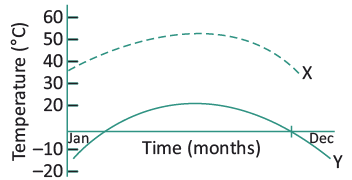
Select the option that correctly identifies the animals that may live at these places.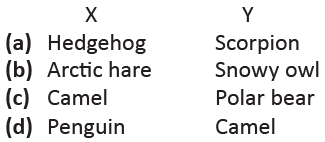
 View Answer
View Answer 
Ans: (c)
Camel is a desert animal while Polar bear is found in cold, polar habitats.
Q49: Select the option that correctly completes any two of the provided blanks:
(i) The paintings in Ajanta caves, Maharashtra depict the life of ___________.
(ii) Cheraw dance, also referred to as bamboo dance, is a well-known folk dance form of ________. (iii) Five Jantar Mantars were constructed in India by __________. (iv) The Qutub Minar has ________ storeys.
(a) (i)-Mahavira, (ii)-Nagaland
(b) (ii)-Mizoram, (iii)-Maharaja Jai Singh II
(c) (i)-Buddha, (iv)-Seven
(d) (iii)-King Narasimhadeva, (iv)-Five
 View Answer
View Answer 
Ans: (b)
- Ajanta caves are famous for their ancient paintings that illustrate the life of Buddha, making option (i) incorrect in this context.
- The Cheraw dance is indeed a traditional dance from Mizoram, confirming option (ii) as correct.
- Jantar Mantar was built by Maharaja Jai Singh II, which makes option (iii) correct.
- The Qutub Minar has five storeys, making option (iv) incorrect.
Q50: The diagram below shows how four magnets are attracted to one another. The poles of the four magnets are marked P to W. Which pair of magnet is not correct. (a)
(a) 
(b)

(c)  (d)
(d) 
 View Answer
View Answer 
Ans: (b)
Like poles repel while unlike poles attract which is not possible as shown.
|
37 videos|80 docs|50 tests
|
FAQs on Science Olympiad Model Test Papers - 1 - Science Olympiad for Class 5
| 1. What subjects are covered in the Class 5 Science Olympiad Model Test Papers? |  |
| 2. How can I prepare effectively for the Science Olympiad exam? |  |
| 3. What is the format of the questions in the Science Olympiad Model Test Papers? |  |
| 4. Are there any recommended resources for studying for the Class 5 Science Olympiad? |  |
| 5. When is the Science Olympiad exam usually held for Class 5 students? |  |
















